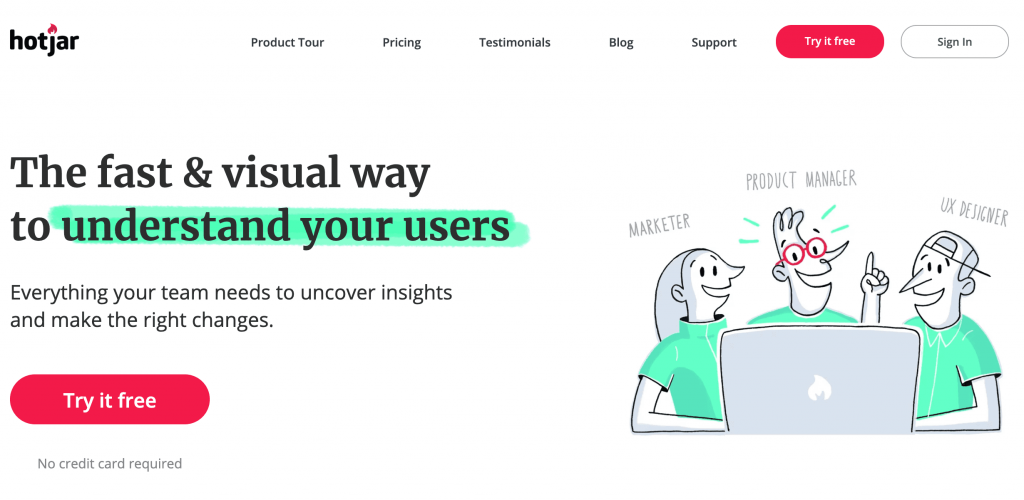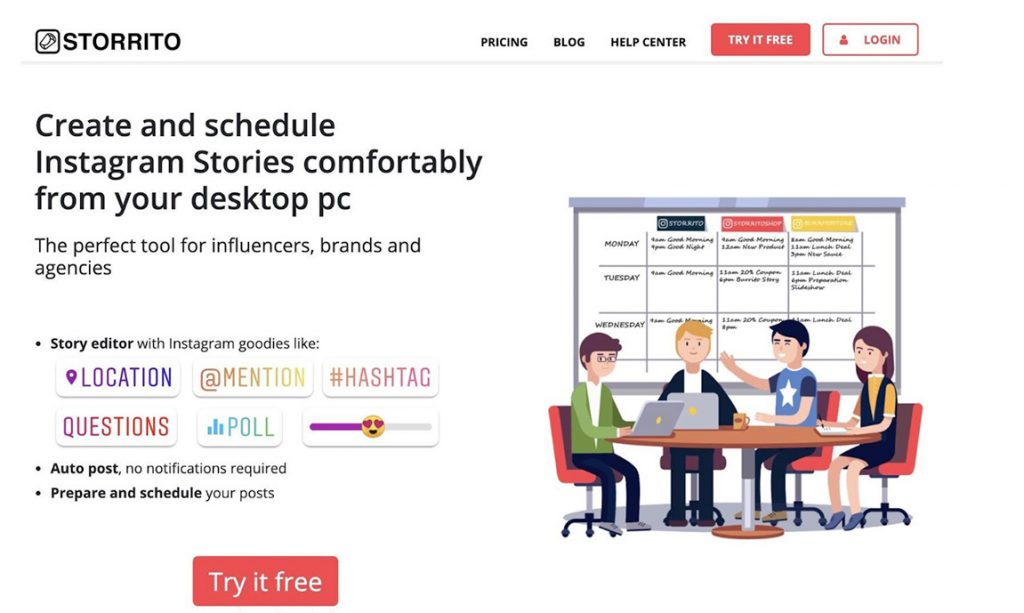Communicating your company’s value proposition is certainly one of the hardest things you can do as a marketer. Getting it right determines the rise or fall of your business.
The purpose of this post is to help you create a compelling value proposition for your product or service. The following framework will certainly get you a competitive advantage in the market.
What does ‘value proposition’ really mean?
Your value proposition serves as an introduction to the market. It highlights the value you promise to deliver to your customer. It also tells a potential customer why to buy your product over the one from your competition.
What are great value proposition examples?
First, let’s have a look at some best practices out there. Below you see 3 of my favorites.
1. Hotjar

The value proposition of Hotjar is especially great because they did everything right. They have a strong value statement, a supporting paragraph, a clear call-to-action and they name their target users in a fun image. Moreover, they use a bright green color to highlight the main benefit of their tool.
2. Value Proposition of Uber

The client value proposition of Uber simply highlights the benefit future employees are looking for – “get paid”! Furthermore, it is nice that they show an image of their typical employee persona, a friendly cab driver reading the newspaper. He is probably just a model but the shirt and the type of sweater certainly make him an ideal cab driver.
How to write a persuasive and unique value proposition?
I will explain my favorite technique with the help of an example. Let’s take Dropbox. A cloud storage service and therefore a rather unemotional software product.
It is fair to assume that no one gets up in the morning and says to himself: “Wow, I need this awesome cloud storage service, today!”
However, companies like Dropbox still need to sell their product. Hence, they need a compelling value proposition.
First, we need to be aware that we are all humans and we are by nature ego-centric. It is always tempting to just tell the story of why we are awesome and why everyone should buy our product.
Boring marketers usually just brag about how great the company is, by saying for example:
“Get our award-winning Cloud Storage Service today – 500 GB for $9.90 a month!”
But to be customer-centric, you have to shift your point of view and forget about what you’re selling and start focusing on what the customer is getting.

Therefore, you first need to remember the following:
People don’t buy product features, they buy the added value the product creates in their life.
Projecting this idea onto our Dropbox example, does that mean adjectives like “the fastest, quickest and newest service” will sell? No it doesn’t!
Instead, you need to use phrases like “Feel safe, your data is backed up securely and protected in the cloud”. This is what the target audience ultimately cares about -> not losing their data!
But seriously, how to come up with a full-fledged value proposition in under 15min?
Simply translate features into benefits by asking the right question: “How does this feature help your customer?”
Doing this over and over again gives you an enormous amount of product benefits to formulate a truly customer-centric value proposition. See the script below:

Now we have some solid punchlines to create a unique and strong value proposition. The final result could look something like this:
You want to work from everywhere and share your files with anyone? Get our Premium Cloud Storage and get the mobility you deserve.
or for a more security aware audience:
You want to focus on your work and don’t have to worry about losing your data? Let our Cloud Storage Service take care of it. We back you up!
You see how easy it can be to write something customer-centric! With this technique, you come up with a bunch of value statements at once. Of course, for the perfect punch line you have to tweak it and A/B Test it a couple of times, but this technique puts you directly in the shoes of your customer.
How to display the value proposition on your landing page?
Once you defined your value proposition, you need to embed it into the above the fold part of your landing page.

Usually, the above the fold part includes the following 6 elements:
- Your value proposition as the main headline
- An explanatory paragraph underlining it
- Calling out your potential customer/user persona
- The main features of your product
- A clear Call to action
- An eye-catching background image (but be careful, not too catchy!)
Instead of explaining each list item one by one, I will simply give you a visual case study. Below you see how I implemented all of the above on the landing page of my brother’s SaaS Company.

As you can see, it tells you instantly what storrito.com does, what benefit it offers and who the ideal user persona is. Moreover, some key features and a clear call to action.
Pro Tips:
Don’t use a background image that is too eye-catching. A/B Tests have shown that for example, human faces are bad for your conversion rate because their eyes are literally too eye-catching, they distract the user from the main focus action. That’s why those manikin illustrations became so common.
Create an ideal buying persona for your service and display them. You can do this with the help of the persuasive technique of “unity”, which I described in another post.
Always challenge and A/B Test your value proposition
Finally yet importantly, you should always test different versions. (Fun fact, a study of Optimizely showed that companies who do multivariate testing get better results from their testing efforts. They found 5 variants per test is a good number to shoot for.)
One very effective way to test different value propositions is the so-call 5-seconds test. It means within 5 seconds it should be clear to a new visitor what you are selling and to whom you are selling it.
So get a fresh pair of eyes, some friends or colleagues will do. Show them your landing page, turn off the screen after 5 seconds and ask them: “What was this page about?” If they cannot answer it -> rework your design. There are also some services out there which can help you with that.
You have a good chance of winning a 5-seconds test if your value proposition answers the following questions:
- What does your product or service do for the customer?
- What problems and pain points of the prospect is it solving?
- What is your unique selling point? What makes you better than the competition?
- It’s easy to understand (no generic marketing phrases)
- Is it persuasive and therefore convincing?
- It calls out your target customer
In the spirit of testing. I invite you to challenge my work and analyze the landing page of my blog conversion-gorilla.com. I am open to your honest feedback.
Summary
“People don’t buy product features; they buy the added value the product creates in their life”
Always raise the question: “How does this product feature help my customer?” and then derive the benefit from it. Do this repeatedly. You will have a bunch of benefits in no time.
Embed your value proposition on the above the fold part of your website. Together with a clear call to action, a call out of your target audience and a paragraph supporting it.

Julian is the Growth and Conversion Specialist for cleverbridge. He consults our top Clients with best practices in E-Commerce & Subscription topics. Together with his team, he is constantly running A/B Tests on our clients’ checkout pages to optimize their overall business.More posts from Julian about conversion rate optimization are available here.